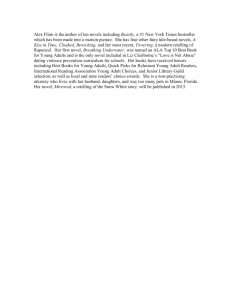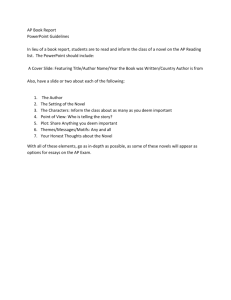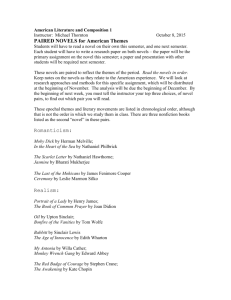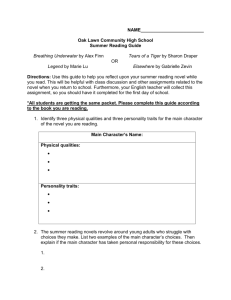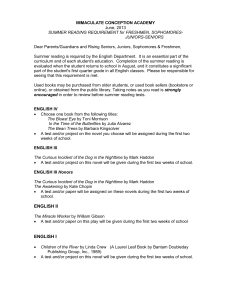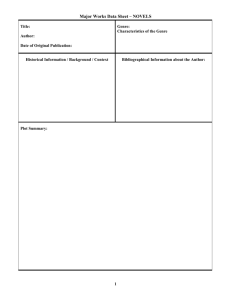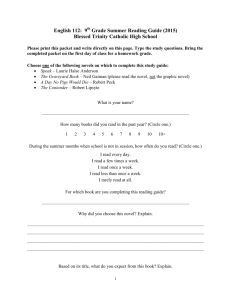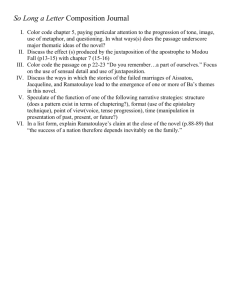Neoclassical Era
advertisement
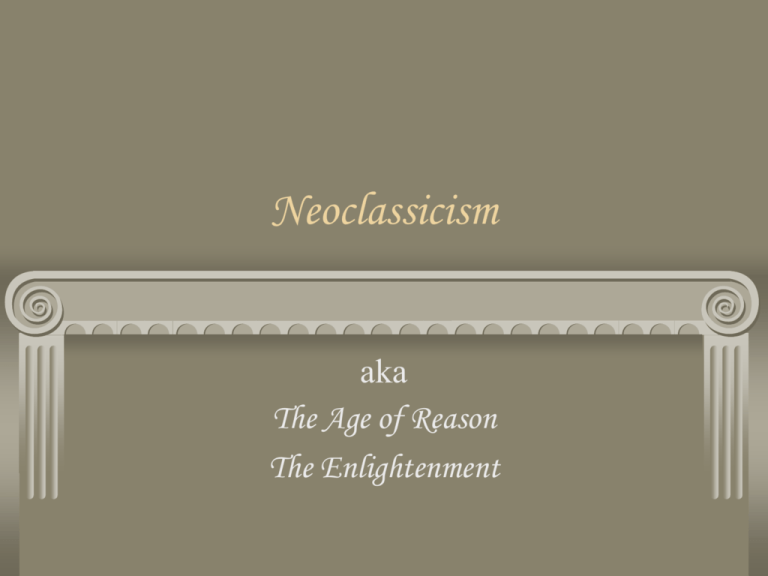
Neoclassicism aka The Age of Reason The Enlightenment Definition Neoclassicism is a literary movement of the 17th and 18th centuries that stressed the importance of using ancient Greek and Roman (the Classical period) literature as a guide for creation and criticism. Hence, there is the paradox of the term: “neo,” meaning “new” and classicism, meaning “oldness.” The Pendulum of Western Literature Literature in the Western world can be thought of as swinging back and forth between two artistic ideals: classicism, which stresses following tradition and the rules derived thereof, and anticlassicism (or romanticism), which stresses originality and breaking tradition. The Neoclassical period of the 17th and 18th centuries was a particularly strong classical period. It would, in turn, be followed by a particularly strong Romantic period in the latter 18th and early 19th century. Aesthetics of Identity vs. Aesthetics of Opposition This pendulum swing can also be thought in terms of the aesthetics of identity versus the aesthetics of opposition. Aesthetics is the study of beauty; in this case, beauty in literature The aesthetics of identity says that we find beauty in the familiar; we like art that is like what we have seen before. Thus, classicism is an aesthetics of identity. The aesthetics of opposition says that we find beauty in that which is new and different. That is the creed of the romantic artist. Basic Characteristics of Neoclassicism Imitation of the ancients Aesthetics of identity Rules for all art forms Literature as an art/craft Importance of reason Concern about pride Universal nature of humanity Perfectibility of humanity 1 -- Reverence and Imitation of the Ancients The explanation of that paradox can be found in the first important characteristic of neoclassicism. It found its artistic models in the classical literature of the ancient Greek and Roman writers like Homer, Virgil, Horace, etc. and in the contemporary French writers such as Voltaire and Diderot. It put the stress on the classical artistic ideal of order, logic, proportion, restrained emotion, accuracy, good taste, and decorum. Who were those authors again? Homer: Greek epic poet: the Iliad and the Odyssey Virgil: Roman poet. His greatest work is the epic poem Aeneid, which tells of the wanderings of Aeneas after the sack of Troy Horace: Roman lyric poet. His Odes and Satires have exerted a major influence on English poetry. Voltaire : French philosopher and writer whose works epitomize the Age of Enlightenment, often attacking injustice and intolerance. He wrote Candide (1759) and the Philosophical Dictionary (1764). Diderot: French philosopher and writer whose supreme accomplishment was his work on the Encyclopédie (1751-1772), which epitomized the spirit of Enlightenment thought. He also wrote novels, plays, critical essays, and brilliant letters to a wide circle of friends and colleagues. Reverence and Imitation of the Ancients They believed that writers should strive to achieve excellence by imitating those great writers of the past, not by trying to be original or innovative. Thus, art is rediscovery, reinvention, and imitation. The Neoclassical Era is actually divided into three ages: 1660-1700 is the Age of Dryden This 40 year period is also called the Restoration b/c Charles II has been restored to the crown John Dryden is especially known for satirical poems. They included unflattering portraits of real people of his time and used lofty, heroic language, so they’re called mock heroic or mock epic poems. He was the poet laureate and wrote several celebratory poems for royal and other public events. More on the Age of Dryden… Prose is the dominant style which flourished during this time, so lots of authors were writing essays. Dryden’s series of essays about drama laid the foundation for British literary criticism. These, along with his translations of Plutarch and other prose compositions, represent what many literary historians consider the first modern prose; they are clear, plain, direct, and colloquial in tone. One of the most famous prose works of the time was Samuel Pepys’ (peeps!) journal which began in 1660 and covered the plague of 1665 and the Great Fire of London. (They ask about this guy a lot on Jeopardy.) The Age of Pope and Swift Early 1700’s to 1744ish Major Political people and parties: o Queen Anne (who makes a rather unflattering guest appearance in Gulliver’s Travels) o Two parties: the liberal Whigs and the conservative Tories came into being. However another party also existed, the Jacobites, who aimed to bring the Stuarts back to the throne. o George I and his government also play a major role in GT, especially in book I, where many allegorical characters appear. More in the Pope and Swift Era Famous stylistic elements: wit, aphorisms, epigrams, antithesis, rhyming couplets, great fondness for satire First literary periodicals appear: The Tatler, The Spectator. Written by Joseph Addison and Richard Steele (famous names!), these one-page papers included crisply written reflective essays and news. The essays quickly became models for other prose writers First English novel published: Robinson Crusoe by Daniel Defoe in 1719 That novel led the way to other types of novels such as… Types of Novels Gothic novel: the novel which exploits the possibilities of mystery and terror in gloomy landscapes, decaying mansions with dark dungeons, secret passages, instruments of torture, ghostly visitations ghostly music behind which lurks no one knows what as the central story, the persecution of a beautiful maiden by an obsessed and haggard villain. The real originator of English Gothic novel was Horace Walpole, with his famous Castle of Otranto (1764) . • These novels, which rebel against the increasing commercialism and rationalism of the era, opened up to later fiction the dark, irrational side of human nature. More Types of Novels Epistolary novel: a type of novel in which the narrative is carried on through a series of letters. Samuel Richardson’s Pamela (1740) and Clarissa Harlowe (1748) are among the best known epistolary novels. These can be classified into two kinds: the monologue epistolary novel and the dialogue epistolary novel The Age of Johnson 1744ish to 1798 Alexander Pope died in 1744 and Swift in 1745, so the dominant figure of the next generation was Samuel Johnson, who wrote poetry, literary criticism, and a novel, but what he’s known for is writing a dictionary. Yes, a dictionary: Dictionary of the English Language, in 1755. His definitions are amusing and witty. Patron: One who countenances, supports or protects. Commonly a wretch who supports with insolence, and is paid with flattery. Hatchet-face: An ugly face; such, I suppose, as might be hewn out of a block by a hatchet. Age of Johnson Another big name of the era is James Boswell because he is known for writing the biography of Dr. Samuel Johnson. It gives a vivid portrait not only of Johnson but of life in London in the 1700’s. Though the other slide had epistolary novels on it (b/c I was doing this whole novels section), Pamela and Clarissa were actually of this era. They were written by Samuel Richardson. Authors to know in case you’re on Jeopardy and the category is The Age of Reason: Henry Fielding, who wrote Tom Jones, and Lawrence Sterne, who wrote Tristram Shandy, which I don’t recommend unless you like experimental novels that get carried away with their own wittiness. The Transition of an Era: the PreRomantics The pendulum begins its major swing to the other side…some of this began around 1750, when Britain was launched on a course of rapid industrialization w/the development of mills and factories belching filth into the sky…families start moving to the cities and toil at machines for 12-14 hours a day… Writers and intellectuals began to lose faith in the ability of human reason to solve every problem. The thinkers in this Age had looked to science to make life better for humanity (see G. Travels, book 3), yet at what cost comes this “progress”? William Blake, Thomas Gray, and Robert Burns are the poets who exemplify the transition from the formal, classical poetic styles of the early 18th century to the more emotional manner of the romantic era. End of the ♫

